Abstract
The life and career of Fred Basolo (1920–2007), dean of American coordination chemistry, 1983 President of the American Chemical Society, and contributor to inorganic chemistry, coordination chemistry, physical chemistry, and chemical education over a span of more than half a century, are discussed in this obituary-tribute.
Fred Basolo Citation1 (), Charles E. and Emma H. Morrison Professor Emeritus of Inorganic and Analytical Chemistry at Northwestern University and 1983 President of the American Chemical Society, died at the age of 87 on February 27, 2007 of congestive heart failure in Skokie, Illinois. He was preceded in death by his wife Mary and is survived by three daughters, a son, and eleven grandchildren.
Figure 1. Fred Basolo, frontispiece from autobiography. Photo by Mitch Jacoby with Fred's Handwriting Citation3. Courtesy of Fred Basolo.
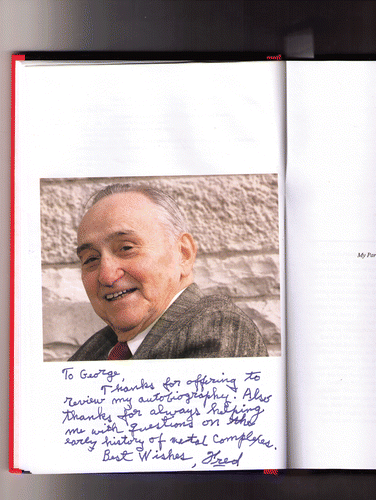
Fred made monumental contributions to inorganic chemistry, chemical education, coordination chemistry, inorganic reaction kinetics and mechanisms, and service to science and society. After his mentor John C. Bailar, Jr. Citation2 died, Fred assumed the position of dean of American coordination chemistry. He summarized his life and career in an autobiography Citation3 and an annotated collection of his most significant papers Citation4. According to Fred,
As I kept writing, I became more and more interested in the many things in my life that I had forgotten ….It almost made me feel that I was again living those years of my life. Another reason for deciding to write my autobiography is to leave it for our children so that they can enjoy reading about the lives of their parents. Furthermore, at age 81 and handicapped, I needed something to do that interested me and kept me busy Citation3, pp. xi-xii].
Fred was born as the youngest of three children on February 11, 1920 to Giovanni and Catherina Basolo, Italian immigrants, “my two role models for life in general” Citation3, p. 2] in the small coal-mining village of Coello, Illinois, about 25 miles north of Carbondale. At Fred's funeral his oldest grandchild, John Michael Kunzer related,
My grandfather's first name on his birth certificate is Alfredo, but he was having problems spelling it, so his mother told him, “Just write Fred.” He never changed it, and for the rest of his life he pursued his work remembering excellence comes through living the simple lessons he learned in Coello Citation5.
Most of the miners were immigrants from the Piedmont region of northern Italy and spoke the “Piemontese” peasant dialect. Until Fred began to attend school, he understood but spoke little English. Conditions in the home were primitive—no central heating or plumbing. Fred's experiences watching his mother in the family kitchen made cooking Italian dishes one of his favorite hobbies. His concern for students, colleagues, family, and everyone with whom he came into contact also may be traced to his roots in Coello.
When Fred was about ten, The Great Depression began. Because he was too young to work, he attended elementary school in Coello and the Christopher Community High School. His first contact with chemistry was in high school, where his teacher told the class she hated the subject, knew little about it, and they were going to be largely on their own. Contrary to the common experience of successful chemists, who usually attribute their success to the motivation provided by an enthusiastic high school teacher, Fred found that her
approach to teaching chemistry gave me the freedom to concentrate on what interested me in the textbook and, even more so, to get very excited about the laboratory experiments Citation3, p. 7].
Aided by a welfare program for college students, Fred enrolled at Southern Illinois Normal School (now Southern Illinois University). He became a chemistry major and earned his B.Ed. degree in 1940. The only person from Coello going to college, today he is still Coello's only Ph.D. His parents expected him to become a high school teacher. However, Chemistry Department chairman James Neckers advised him to go to graduate school.
A teaching assistantship enabled Fred to enter the University of Illinois. He chose as his mentor John C. Bailar (1904–1991), the father of American coordination chemistry, “a professor knowledgeable in organic chemistry doing work in inorganic chemistry which, to me, seemed a win-win situation” Citation3, p. 14]. He thought that Bailar “seemed to be a caring person, with a good understanding of people and their needs” Citation3, p. 14], qualities for which Fred later became legendary. Bailar became his second role model after his parents. As Bailar's most eminent doctoral student, Fred continued Bailar's work with his own students, and after Bailar's death in 1991 he inherited his position as the “grand old man of coordination chemistry in the United States.”
Since Bailar worked with octahedral cobalt(III) complexes, he wished to extend this research to planar platinum(II) and octahedral platinum(IV) coordination compounds. For his dissertation, Fred synthesized optically active cis-[PtCl2{NH2CH2CH2NH2}2]Cl2 and studied the stereochemical changes occurring during its ligand substitution reactions. His second publication on this subject Citation6, describing this research, aroused little interest until more than two decades later, when Barnett Rosenberg discovered the anti-tumor activity of the related complex, cis-[PtCl2(NH3)2] (cisplatin), now one of the most widely used anti-cancer drugs Citation7.
Bailar advised Fred to complete his research in three years so he would not be drafted and need to return to Illinois to receive his degree. Fred received his M.S. degree in 1942 and his Ph.D. degree in 1943. He worked for three years on governmental classified research at Rohm & Haas Co. in Bridesburg, a Philadelphia suburb.
In 1946 Fred became Instructor of Chemistry at Northwestern University. On June 14, 1947 Fred married Mary Nutely in Longmeadow, Illinois, the beginning of an extremely long and happy marriage that resulted in three daughters and a son, all of whom became educators. At NU Basolo rose through the ranks—Instructor (1946–50), Assistant Professor (1950–55), Associate Professor (1955–58), Professor (1958–79), and Charles E. and Emma H. Morrison Professor of Chemistry (1980–90). He served as Chairman of the Chemistry Department from 1969 to 1972.
A Guggenheim fellowship allowed the Basolos to spend a sabbatical year (1954–55) in Copenhagen, where Fred worked in the laboratory of Jannik Bjerrum Citation8, whose dissertation popularized the term ligand Citation9. The Basolos visited other European countries, including Italy, where they visited Fred's relatives. A passionate lifelong golfer, Fred played at the Royal and Ancient Golf Course in St. Andrews, Scotland, where the game originated.
During his time in Copenhagen Fred wrote several chapters of the book that made an international reputation for him and his NU colleague Ralph G. Pearson. Their classic book, Mechanisms of Inorganic Reactions Citation10, introduced crystal field theory to chemists and showed its power to explain properties of coordination compounds as well as kinetics and mechanisms of redox and ligand substitution reactions. This critically acclaimed landmark monograph has been compared to Alfred Werner's Neuere Anschauungen auf dem Gebiete der anorganischen Chemie Citation11, and Fred's fellow Bailar student Daryle H. Busch proclaimed it the “Bible of inorganic mechanisms” Citation3, p. 82].
During the summer of 1955 Fred and Mary attended the 3rd International Conference on Coordination Chemistry (3 ICCC) at Amsterdam. Fred heard the plenary lecture by Walter Hieber of the Technische Universität München, the “father of metal carbonyl chemistry,” and asked him about the mechanisms involved in the synthesis and reactions of these compounds. Hieber replied, “We do chemistry in my laboratory, not the philosophy of chemistry” Citation3, p. 101]. Fred realized this was a neglected field that he and his students could study.
The Basolos spent Fred's second sabbatical year (he was a Senior NSF Fellow, 1961–62) at Vincenzo Caglioti's institute at the Università di Roma. Fred invited Anthony J. Poë, who was on sabbatical leave from Imperial College, London, to supervise his research group of about a dozen graduate students. In addition to his work on metal carbonyls, Poë worked with Fred's student John L. Burmeister on his discovery of linkage isomers of LnM-NCS and LnM-SCN)Citation12, the first case of linkage isomerism Citation13 since Sophus Mads Jørgensen's discovery of the xantho (nitro) ([Co(NO2)(NH3)5]Cl2) and isoxantho (nitrito) [Co(ONO)(NH3)5]Cl2 pentaammines of cobalt(III) Citation14. During his year at Rome, Fred wrote the first two chapters of his second book, Coordination Chemistry, a popular supplementary paperback coauthored with former student Ronald C. Johnson, which was translated into seven languages Citation15.
While browsing in the Rohm and Haas library Fred had become interested in studies of the kinetics and mechanisms of substitution reactions on carbon carried out by organic chemists. It now occurred to him that such studies could be made on inorganic coordination compounds such as those of cobalt(III) and platinum(II), with which he was already familiar. Lacking expertise in kinetics and mechanisms, he was fortunate in that fellow Instructor and physical organic chemist Ralph G. Pearson was carrying out such studies with carbon compounds. After persistent efforts Fred succeeded in convincing Ralph to collaborate on similar studies on coordination compounds, although no NU graduate students were interested in inorganic chemistry. Their first joint paper appeared in 1952 Citation16. According to Fred,
Ralph and I arrived at the right place at the right time, resulting in the publication of some 60 co-authored papers on the kinetics and mechanisms of ligand substitution of octahedral and square planar metal complexes. Neither one of us could have done what we did alone, but, by working together, we were very successful. The seminal results of our studies are now often used in bioinorganic chemistry research, and in studies on homogeneous catalysis Citation3, p. 3].
Fred and Ralph found the base hydrolysis of cobalt(III) complexes to proceed by an SN1CB (substitution, nucleophilic, unimolecular, conjugate base) mechanism, whereas Sir Christopher K. Ingold and Sir Ronald S. Nyholm claimed that this view was incorrect and stated that the correct mechanism was SN2 (substitution, nucleophilic, bimolecular). In Fred's words,
Had our polemic with Ingold and Nyholm, two of the giants of chemistry, not turned out in our favor, we may not have gotten tenure and our department may not now rank among the top four in inorganic chemistry in the U.S. We were very fortunate to have this exchange focus so much favorable attention on our department just at the time when inorganic chemistry in the U.S. was beginning to achieve the importance it now has Citation3, pp. 90–91].
According to Ralph,
Fred was also a great teacher. I often quipped that he was a far better teacher than I was. Over the years he taught me much inorganic chemistry, but I was never able to teach him any physical chemistry. He made many other contributions to making inorganic chemistry one of the hot research areas of chemistry. Summing up, Fred Basolo was a worthy successor to John Bailar as the Father of American Inorganic Chemistry Citation17.
Fred and Ralph's studies of ligand substitution reactions of octahedral cobalt(III) complexes, acid hydrolysis or aquation of cobalt(III) and chromium(III) metal-ammine complexes, base hydrolysis of metal-ammine complexes, linkage isomers, ligand substitution reactions of Pt(II) square planar complexes, synthetic oxygen carriers, and organometallic chemistry, including the indenyl kinetic effect are true chemical classics Citation18. Fred also made forays into the field of biological inorganic chemistry.
Northwestern University's Chemistry Department is famed for the intimate interaction between faculty and students. The informal Basolo-Ibers-Pearson (BIP) meetings, where graduate students or postdoctoral fellows presented their results on research in progress, are known worldwide and have become legendary. Fred's doctoral student Alvin L. Crumbliss remembers:
The meetings were always held on Saturday mornings, as an indication that Saturday was to be treated as another working day, as it was by most of us ….Many of the names in inorganic chemistry from Europe would make it a point to stop by NU to give a Friday colloquium talk, and then stay on for a BIP group meeting talk on Saturday morning. This often led to being invited to Fred's house for dinner with the speaker. Mary and Fred were both excellent hosts. The food was great and Fred's after dinner drink collection was memorable Citation19.
Like John Bailar, his mentor, Fred educated several generations of chemists (58 doctorates, 66 postdoctoral fellows, and numerous bachelor's and master's degree candidates). About one-third of his students, inspired by his love of teaching, entered academia. The list of his former students is a virtual “Who's Who” of inorganic chemistry and chemical education. Like Bailar's, Fred's success as a research supervisor and teacher owed as much to his enduring human qualities as to his considerable chemical knowledge. In 1992 he received the ACS George C. Pimentel Award in Chemical Education, and in 2001 he was awarded the Priestley Medal, the ACS's highest honor Citation20. He was also the recipient of numerous awards, medals, and honorary degrees.
Fred was very active in the Gordon Research Conferences, International Conferences on Coordination Chemistry (ICCC) (), ACS Petroleum Research Fund Advisory Board, and North Atlantic Treaty Organization (NATO). He was elected to the National Academy of Sciences (1979), and he considered one of his most important NAS activities his participation in the book, Opportunities in Chemistry— the “Pimentel Report” Citation21. In spite of his numerous professional activities and more than 380 scientific publications, he served as editor of journals or volumes Citation22 and wrote letters of recommendation, award nominations, or forewords to books or monographs Citation23.
Figure 2. Ralph G. Pearson (third from left) and Fred Basolo (fifth from left) at the Eighth International Conference on Coordination Chemistry (8 ICCC), Vienna, Austria, September, 1964. Courtesy of Ralph G. Pearson.
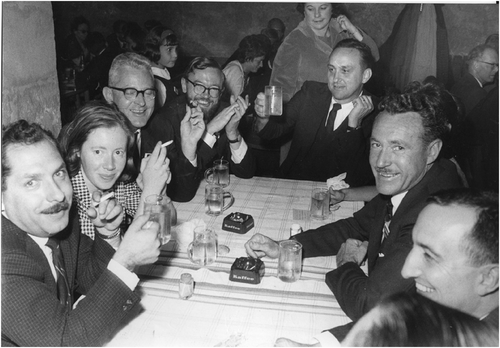
In 1970 Fred was elected Chairman of the ACS Division of Inorganic Chemistry. Although he had not been very active in the ACS and thought he had little chance of being elected President, he agreed to having his name proposed as a petition candidate opposing the two candidates loyal to the ACS establishment, who would receive all the establishment votes. Surprisingly he was elected 1983 ACS President without any electioneering.
As President, Fred tried to correct some of his longtime concerns. In his attempts to combat chemophobia he agreed to discuss environmental problems with newspaper reporters, radio talk show hosts, and television anchor persons but only if he was given equal time to present the beneficial aspects of chemicals. He also made these views known to congressmen and congressional committees. Not all of Fred's presidential efforts bore fruit. He concluded that
My year as President of the ACS was a rewarding experience for me. I learned that one cannot succeed in making major changes in an organization deeply entrenched in its policies. However, … some of what was done made significant contributions to chemistry Citation3, p. 136].
Fred traveled to 40 foreign countries, meeting with colleagues and encountering unusual foods and customs. His zest for life and remembrance of the humble circumstances of his childhood made him take great delight in each new experience during these trips. He considered Italy a second home, where he lectured in his “bad, but amusing Italian” Citation3, p. 156], and traveled there “more times than I can recall” Citation3, p. 153]. In 1981 he was elected an honorary member of the Società Chimica Italiana, and he received honorary doctorates from the Università di Torino (1987), the Università di Padova (1991), and the Università di Palermo (1997) as well as three Italian medals. In 1987 he was elected, one of only ten foreign members, five of whom were Nobel laureates, to the Accademia Nazionale dei Lincei, founded in 1603 as the world's oldest scientific society.
On August 17–18, 1990 a huge celebration of Fred's 70th birthday and his retirement, known as Basolo 70, financially supported by 16 corporations and societies and attended by almost all of his Ph.D. students and postdocs, was held Citation24 (). Enough funds were left so that his students and postdoctoral fellows created an endowment to establish an annual Basolo Medal () and Lecture, beginning in 1991. Governor James Thompson proclaimed August 18, 1990 “Fred Basolo Day in the State of Illinois.”
Figure 3. Basolo 70, Northwestern University, August 17–18, 1990, Fred Basolo (fourth from left) and Ralph G. Pearson (fifth from left). Courtesy of Kenneth N. Raymond.
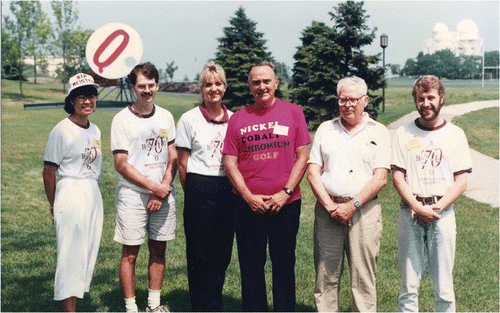
Figure 4. Fred (left) and Mary (right) Basolo at presentation of Basolo Medal to and Lecture given by Harry B. Gray, Northwestern University, 1994. Courtesy of Andrew Wojcicki.
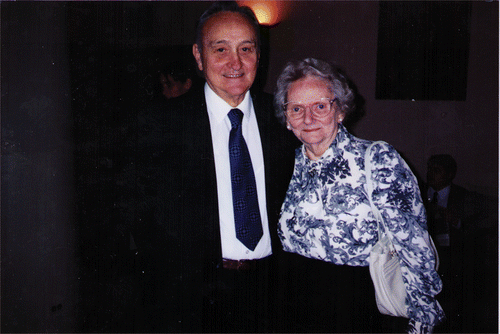
Unfortunately, in 1991 Mary had an emergency quadruple heart bypass and began to suffer from Alzheimer's disease. One morning, while driving her to the day-care center, Fred fell asleep at the wheel because of a combination of some new medications and tiredness, and the car hit a tree. Mary died of her injuries on February 5, 1997. Five surgeries on Fred's back damaged the nerves from his brain to his legs, and he was unable to walk without two canes. He used a motorized scooter to get around in the NU Chemistry Building (). In spite of pain and shortness of breath, he came to his office in the morning, had lunch with his faculty colleagues, and left in the early afternoon. Despite the illness and pain of his last days, Fred never felt sorry for himself or forgot his former students:
While his body failed, his mind remained active. He distributed to me and his other ex students many items over the last couple of years, obviously in anticipation of his death. Like the rest of his life, he was organized and thinking of others even as the end of his own life approached Citation25.
Figure 5. Fred Basolo on his motorized scooter at Department of Chemistry, Northwestern University Citation20. Photograph by Mitch Jacoby.
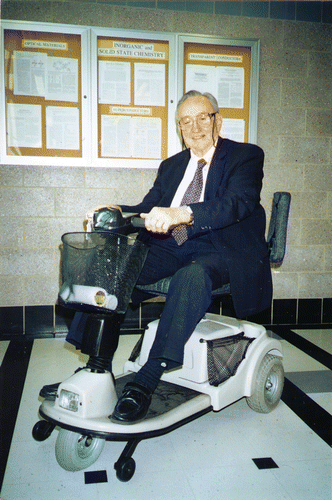
Fred's life and career is a rags to riches saga of a person committed both to the practice of scientific research and to his profession. His contributions to chemistry, personality, warmth, sense of humor, charm, and intense interest in people endeared him to generations of colleagues and students.
Proud of his roots but humble about his accomplishments, Fred wrote:
I can truthfully say that I marvel at what has happened to me during my life. Not in my wildest dreams could I have expected when growing up in the little mining village of Coello that, some day, I would become a successful chemist Citation3, p. 221].
He concluded the autobiography depicting his triumph and tragedy with the positive outlook on life expressed by his wife Mary: “Happiness Always” Citation8, p. 221].
Acknowledgments
We are greatly indebted to Robert J. Angelici, John L. Burmeister, Alison Butler, James P. Collman, Alvin L. Crumbliss, James A. Ibers, Ronald C. Johnson, Kazuo Nakamoto, Thomas V. O’Halloran, Ralph G. Pearson, David H. Petering, Anthony J. Poe, Kenneth N. Raymond, William C. Trogler, and Andrew Wojcicki for their contributions to this obituary.
References
- March 8 2007 . observeronline News for the Northwestern University Community March 8 , http://www.northwestern.edu/observer/issues/2007/03/08/basolo.html; T. Jensen, Chicago Tribune, p. 8, March 7 (2007); H. Gray and J.S. Magyar, Angew. Chem., Int. Ed. 46, 1 (2007); R. Petkewich, Chem. Eng. News 85 (10), 13 (2007); D.F. Shriver, Coord. Chem. Rev. 99, 3 (1990); J.L. Burmeister, Inorg. Chim. Acta 240, xxiii (1995); J.L. Burmeister, Chemtracts—Inorganic Chemistry 13, 73 (2000), Fred Basolo's Web site: http://66.49.160.113;
- Kauffman , GB , Girolami , GS and Busch , DH . 1993 . Coord. Chem. Rev , 128 : 1 T.L. Brown, University of Illinois School of Chemical Sciences Alumni Newsletter, Fall 1991, insert
- Basolo , F . 2002 . From Coello to Inorganic Chemistry: A Lifetime of Reactions , New York, , Boston, Dordrecht, London, Moscow : Kluwer Academic/Plenum Publishers .
- Basolo , F and Burmeister , JL . 2003 . On Being Well-Coordinated: A Half-Century of Research on Transition Metal Complexes: Selected Papers of Fred Basolo , Singapore, River Edge, NJ : World Scientific Publishing Co. .
- Kunzer , JM . “Fred Basolo's Greatest Lessons,” a six-page tribute spoken at Fred's funeral by his oldest grandson, courtesy , Margaret Ann (Peggy) Silkaitis (née Basolo) .
- Basolo , F , Bailar , JC , Jr. and Tarr , BR . 1950 . J. Am. Chem. Soc. , 72 : 2433
- Rosenberg , B , Camp , IVan and Krigas , T . 1965 . Nature , 205 : 698 G.B. Kauffman and D.O. Cowan, Inorg. Syn. 7, 239 (1963); G.B. Kauffman, Curr. Contents: Phys., Chem., & Earth Sci. 28 (6), 20 (1988)
- Kauffman , GB . 1985 . J. Chem. Educ. , 62 : 1002
- Brock , WH , Jensen , KA , Jørgensen , CK and Kauffman , GB . 1981 . Ambix , 28 : 171
- Basolo , F and Pearson , RG . 1958 . Mechanisms of Inorganic Reactions , New York, NY : John Wiley & Sons, Inc. . 2nd ed. (1967)
- Kauffman , GB . 1959 . Am. Scientist , 47 : 272A
- Basolo , F , Burmeister , JL and Poë , AJ . 1963 . J. Am. Chem. Soc. , 85 : 1700
- Burmeister , JL . 1968 . Coord. Chem. Rev. , 3 : 225
- Jørgensen , SM . 1894 . Z. Anorg. Chem. , 5 : 147
- Basolo , F and Johnson , RC . 1964 . Coordination Chemistry , New York : W. A. Benjamin . 2nd ed., Science Reviews, Wilmington, DE (1986)
- Pearson , RG , Boston , CR and Basolo , F . 1952 . J. Am. Chem. Soc. , 74 : 2943
- Pearson , RG . 2007 . March 27 E-mail to G. B. Kauffman
- Basolo , F . 1990 . Coord. Chem. Rev. , 100 : 47
- Crumbliss , AL . 2007 . March 16 E-mail to G. B. Kauffman
- Jacoby , MA . 2001 . Chem. Eng. News , 79 ( 14 ) April 2 : 59 – 63 . http://center.acs.org/applications/ccs/application/index.cfm?pressreleaseid=1631&categoryid=13; http://pubs.acs.org/cen/coverstory/7914/7914basolo.html
- Pimentel , GC and Coonrod , JA . 1985 . Opportunities in Chemistry , Washington, DC : National Academy Press . Opportunities in Chemistry Today and Tomorrow, National Academy Press, Washington, DC (1987)
- Basolo , F , Bunnett , JF and Halpern , J . 1973 . Collected Accounts of Transition Metal Chemistry , Vol. 2 , Washington, DC : American Chemical Society . (1977), For example
- Ray , RK and Kauffman , GB . 1999 . Metal and Nonmetal Biguanide Complexes , New Delhi, , India : Foreword by Fred Basolo, New Age International (P), Ltd. . For example
- Burmeister , JL . 1990 . Coord. Chem. Rev , 105 Special 269-page issue with 11 papers by former students
- Raymond , KN . 2007 . February 27 E-mail to Peggy Silkaitis (née Basolo)